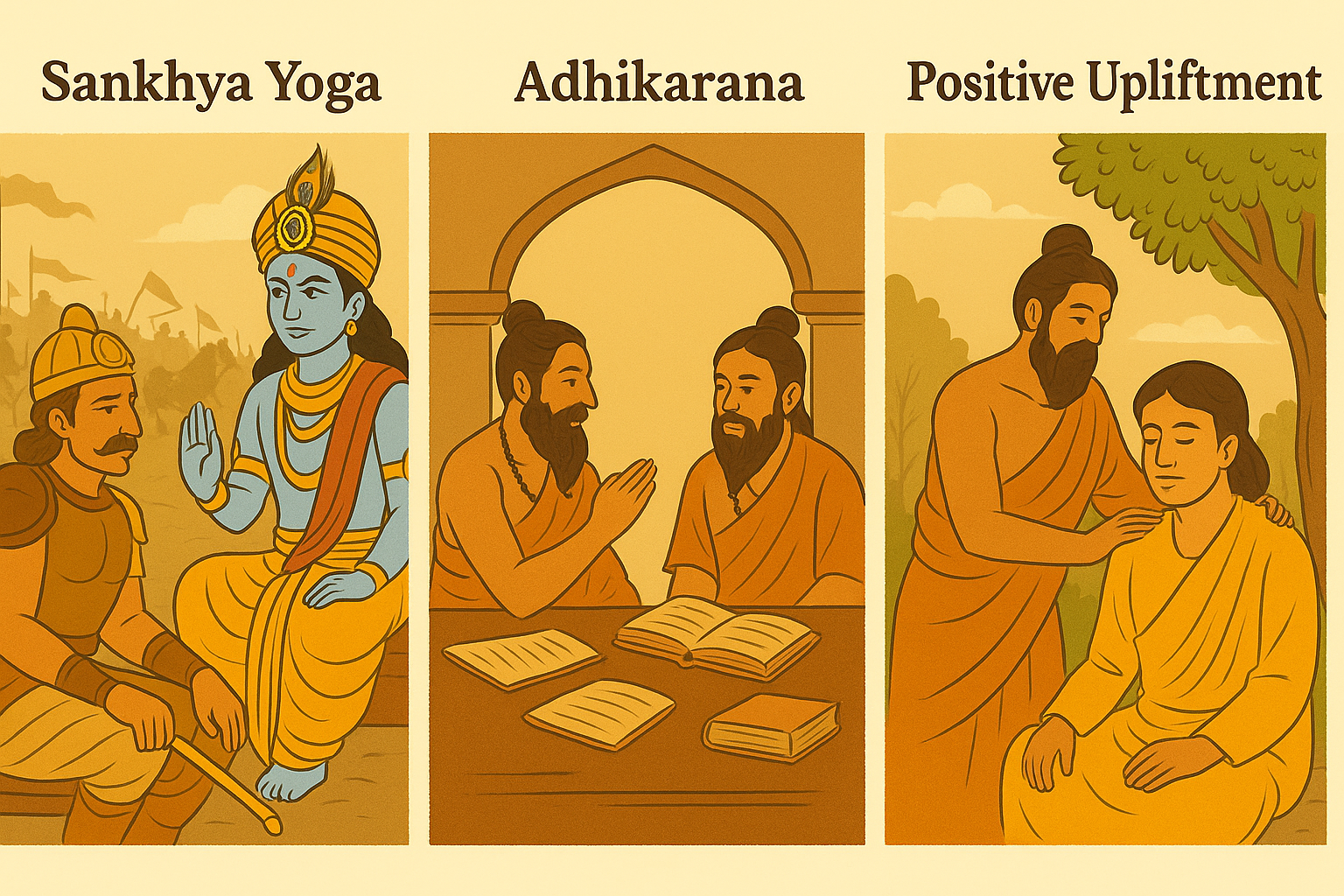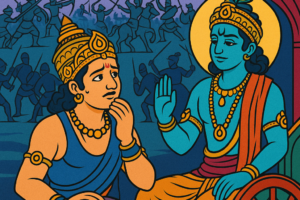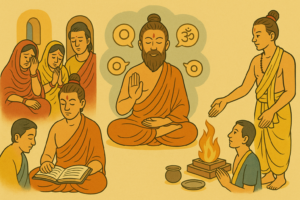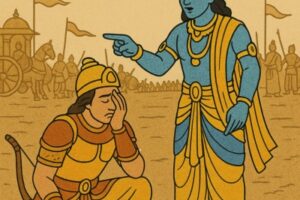
Sankhya Yoga, Adhikaraṇa & Positive Upliftment
- Posted by Sri Kameswari Foundation
- Date July 15, 2025
- Comments 0 comment
As we begin exploring the second chapter of the Bhagavadgītā — Sankhya Yoga — let us also reflect on the themes of Sankhya Yoga, Adhikaraṇa,and Positive Upliftment.
Sankhya Yoga
Yoga is often misunderstood today as merely a good morning routine.In contrast,Yoga in its true sense is a state of communion with one’s own Self.
Let us understand why Yoga is essential.The common tendency of the mind is to run after sense objects, leading to a state of restlessness.To perceive reality clearly,our intellect(buddhi) must function properly.Otherwise,we fall into misinterpretations and poor decision-making.Such a life does not fulfil the very purpose of human birth — which is to realise the Self.
Yoga is the process of calming this agitated mind and reconnecting it with its source.This is why each chapter of the Bhagavadgita is named a “Yoga”,as each discusses a unique path to this union.
Sankhya means knowledge,and Sankhyam refers to that which is related to knowledge.Just as the land ruled by King Bharata is called Bharatadesha,this path is called Sankhya Yoga — the Yoga of Knowledge.
As discussed in our earlier posts,real knowledge is that by knowing which,everything else becomes known — this is Para Vidya.
Often,we use the word Jnana to mean knowledge.But the knowledge we gather through our Jnanendriyas (sense organs) and Karmendriyas (organs of action) is Apara Jnana,or lower knowledge.Such knowledge does not lead to Yoga.It is Tattva Jnana — knowledge of the ultimate Truth — that leads to communion with the Supreme Consciousness.
This Tattva Jnana is what Bhagavan Sri Krishna expounds through Sankhya Yoga in the Bhagavadgita.
Thus,Sankhya Yoga is the path of knowledge that leads to union with the Supreme Self.
Adhikaraṇa
We find Adhikaraṇas in the Brahmasūtras,which can be loosely related to theorems or axioms in modern terminology.
As the Brahmasūtras deal with the nature of the Supreme Self (Brahman),these truths are explored through various Adhikaraṇas.Each Adhikaraṇa presents a detailed discussion aimed at arriving at a truth pertaining to an existential reality — something not easily grasped through the Jñānendriyas (sense organs),but rather through darśana — the experiential establishment of oneself within the Supreme Consciousness.
Each Adhikaraṇa typically consists of two main parts:
Pūrvapakṣa:The preliminary argument,representing the view of an opponent who brings forward objections to the sūtra,supported by seemingly rational arguments.
Siddhānta:The established conclusion after thorough inquiry — the ultimate truth (siddha-antaḥ = “that which is established at the end”).
Let us understand this with an example — the famous Vaiṣamyanairghṛṇyādhikaraṇam,which deals with the supposed partiality of Īśvara(God) in creation.
Pūrvapakṣa (Objection)
The objector argues that God is biased — some beings are born wealthy,healthy,and happy, while others suffer lifelong distress.Some are born as humans to enjoy pleasures, while others are born as animals or birds.This,according to the opponent,indicates that Īśvara is partial and has preferences for certain countries,families,or individuals.
Siddhānta (Conclusion)
The Siddhāntin responds that Īśvara is impartial and unaffected, like a cloud(parjanyaḥ) that rains wherever atmospheric conditions are conducive — without bias towards time,place,or person.
Similarly,though Īśvara is the ultimate cause of creation (nimitta kāraṇa),what each being experiences is the result of their own karma — the accumulated merits and demerits (puṇya-pāpa sañcaya).This is called viśeṣa kāraṇa — the specific cause that determines an individual’s experience,such as birth in a particular family,country,or lifeform.
Īśvara,therefore,is not the cause of inequality through preference but is the provider of a field (karma-kshetra) where beings experience the results of their own actions.He showers his grace equally on all beings.
According to Karma Siddhānta, beings are allotted to different lokas(realms) based on their karmic fruits —
Bhūloka – where both pleasure and pain are experienced,
Svargaloka – a realm of pleasures,
Narakaloka – a realm of suffering,
and so on.
This forms the basis for a Sanātanī to live with a sense of responsibility,knowing that every action has consequences.
Ironically,while Karma Siddhānta is widely spoken about today,it is rarely applied sincerely in action.This gap between knowing and living needs to be bridged.It can be done by cultivating a yogic way of living — through daily nitya anushṭhāna(regular spiritual practice),satsanga (not just company of good people,but also deep study of great teachings),niṣkāma sevā (selfless service), and disciplined introspection.
Positive Upliftment
Often,we react unpleasantly towards our close ones when they don’t behave as we expect.
We are quick to express our disappointment,even when they are already feeling low,and in doing so,we may make them feel worse.We tend to highlight their shortcomings and blame them entirely for their actions.
But instead of pointing fingers,if our intention is to help them return to a state of balance,we should focus on the positive qualities they possess.Every individual has certain strengths and goodness within them.
No one should be allowed to remain in a state of dejection. When a person is in such a state, they find it difficult to think positively and are more vulnerable to absorbing negative energies—even if,by nature,they are not inclined that way.
Therefore,it is essential to remind them of their virtues and uplift them emotionally and psychologically,rather than responding with complaints or criticism.If we genuinely want to support and motivate them in their difficult times, this is the path to take.
Our heart is often compared to the valve of a hand pump — it can hold only one thing at a time. So,to prevent negativity from entering and to stay rooted in positivity, ur revered Gurus have always guided us to engage in tapas,satsanga,nāma sankīrtana,and similar practices.
Let us bring all of this together and begin our journey into the eternal teachings of Bhagavān Sri Krishna through Sankhya Yoga.
You may also like

Ch-2|Meaning of Shlokas 4&5

Mourning Rituals,Śabda-Brahma & Devatā,Brāhmaṇa Dharma

